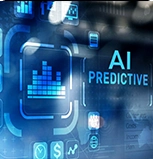back
Tailored Generative AI: Crafting Custom Solutions for Enterprise Innovation
Author

Sri Vidya Teki
CloudAngles

Introduction:
Imagine a world where AI can generate personalized marketing campaigns, accelerate drug discovery, and design innovative products. This future is becoming a reality, all credits to the power of generative AI. However, to fully harness the potential of this transformative technology, enterprises must move beyond generic models and explore tailored solutions that align with their specific needs and goals.
The Need for Customization
Domain-Specific Knowledge
- Generic models, while versatile, may lack the deep understanding required for complex tasks within specific domains.
- For instance, a model trained in general medical data might struggle with nuanced diagnoses in a specialized field like oncology.
- Custom models can be trained on domain-specific datasets to acquire the necessary expertise.
- This ensures that the model can make accurate and informed decisions in the target domain.
Data Privacy and Security
- Enterprises often handle sensitive data that should not be shared with public models.
- Custom solutions offer a way to train models on private datasets, ensuring data privacy and security.
- This is particularly important for industries like healthcare, finance, and manufacturing, where data breaches can have severe consequences.
- By keeping data within the enterprise, organizations can mitigate the risk of unauthorized access or misuse.
Efficiency and Cost-Effectiveness
- Tailored models can be optimized for specific tasks, leading to improved efficiency and reduced computational costs.
- For example, a custom model designed for image recognition can be optimized to focus on specific features or patterns relevant to the task.
- This can result in faster processing times and lower energy consumption.
- Additionally, custom models can be tailored to specific hardware configurations, maximizing performance and efficiency.
Crafting Custom Solutions
Identify Specific Needs
- Clearly define the problem you want to solve or the task you want to automate.
- This will guide the development of your custom model and ensure that it is aligned with your business objectives.
- Consider the specific outcomes you desire and how the model can contribute to achieving them.
- A well-defined problem statement will help you focus your efforts and make informed decisions throughout the development process.
Gather and Prepare Data
- Collect high-quality, relevant data that accurately represents the domain you're targeting.
- Ensure data cleanliness and consistency for optimal model performance.
- Remove any outliers or inconsistencies that could bias the model's training.
- Consider data augmentation techniques to increase the diversity of your training data and improve model generalization.
Choose the Right Architecture
- Select a generative AI architecture that best suits your task.
- Options include GANs (Generative Adversarial Networks), VAEs (Variational Autoencoders), and Transformers.
- Each architecture has its own strengths and weaknesses, so carefully evaluate which one is most appropriate for your specific needs.
- Consider factors such as the complexity of the task, the nature of the data, and the desired output format.
Train and Fine-Tune
- Train your model on your prepared dataset, adjusting hyperparameters as needed to optimize performance.
- Experiment with different hyperparameters to find the best combination for your model.
- Consider transfer learning to leverage knowledge from pre-trained models, which can accelerate training and improve performance.
- Continuously monitor the model's training progress and make adjustments as necessary.
Evaluate and Iterate
- Continuously evaluate your model's performance and make improvements based on the results.
- Use appropriate metrics to measure the model's accuracy, precision, recall, and other relevant performance indicators.
- Identify areas where the model is underperforming and explore ways to address these issues.
- Iterative development is key to refining custom solutions and ensuring that the model meets your expectations.
Real-World Applications
Marketing and Advertising
- Content Creation: Generating marketing content, such as social media posts and email campaigns.
- Personalized Advertising: Targeting ads to specific audiences based on their interests and demographics.
- Market Research: Analyzing market trends and consumer behavior to inform marketing strategies.
Healthcare
- Drug Discovery: Generating new drug candidates by simulating molecular interactions.
- Medical Image Analysis: Analyzing medical images, such as X-rays and MRIs, to detect abnormalities.
- Personalized Medicine: Creating personalized treatment plans based on individual patient data.
Manufacturing
- Product Design: Generating new product designs based on customer preferences and market trends.
- Quality Control: Inspecting products for defects using computer vision and machine learning.
- Supply Chain Optimization: Optimizing supply chain operations to improve efficiency and reduce costs.
Finance
- Fraud Detection: Identifying fraudulent activities by analyzing patterns in financial data.
- Risk Assessment: Assessing financial risks and predicting market trends.
- Algorithmic Trading: Developing automated trading strategies based on AI models.
Entertainment and Media
- Video Game Development: Generating realistic characters, environments, and storylines.
- Music Composition: Creating original music compositions in various styles and genres.
- Film and Animation: Generating special effects, backgrounds, and even entire scenes.
Education
- Personalized Learning: Creating customized educational content tailored to individual students' needs and learning styles.
- Language Learning: Generating realistic language practice materials, such as dialogues and conversations.
- Virtual Tutors: Providing personalized tutoring and guidance to students.
Art and Design
- Art Generation: Creating unique and original works of art, such as paintings, sculptures, and digital art.
- Fashion Design: Generating new clothing designs and patterns based on trends and customer preferences.
- Interior Design: Creating virtual renderings of interior spaces to help clients visualize design concepts.
Customer Service
- Chatbots: Providing automated customer service through chat interfaces.
- Personalized Recommendations: Recommending products or services based on customer preferences and behavior.
- Sentiment Analysis: Analyzing customer feedback to identify areas for improvement.
Overcoming Challenges
Implementing custom generative AI solutions can present challenges, such as data quality issues, computational resources, and ethical considerations. However, by addressing these challenges proactively and leveraging the expertise of AI experts, enterprises can successfully deploy tailored solutions.

Discover the potential of mlangles Generative AI!
Explore innovative use cases that can transform your business.
read moreConclusion:
Tailored generative AI offers enterprises a powerful tool for driving innovation and solving complex problems. By crafting custom solutions that align with their specific needs, businesses can unlock the full potential of this transformative technology. From accelerating drug discovery to creating personalized marketing campaigns, the possibilities are limitless.
As AI continues to evolve, the opportunities for custom applications will only expand. By staying ahead of the curve and investing in tailored generative AI solutions, enterprises can position themselves for long-term success in today's competitive landscape.



